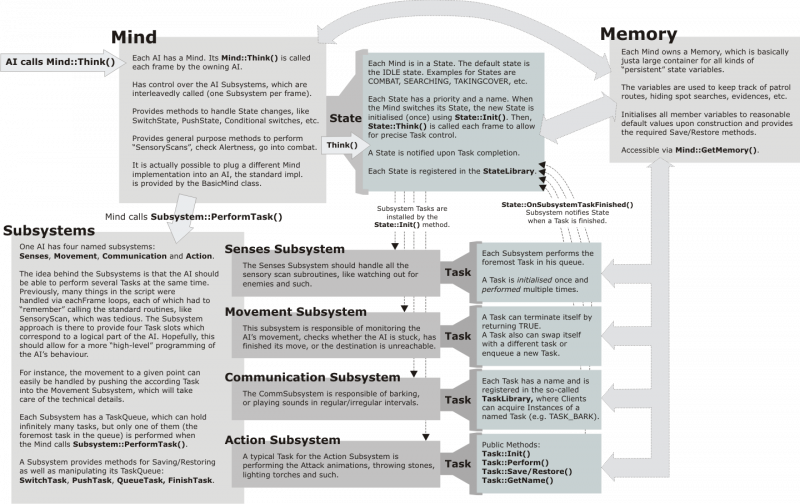AI Framework: Difference between revisions
m (→Subsystems) |
|||
| Line 11: | Line 11: | ||
For example, an attacking AI has several Tasks to perform: chase the enemy, watch out for his position and attack him when he's near enough. Translated into the Subsystem framework this would be: Push a ChaseEnemyTask into the Movement Subsystem, a CombatSensoryTask into the Senses Subsystem and the CombatTask into the Action subsystem. | For example, an attacking AI has several Tasks to perform: chase the enemy, watch out for his position and attack him when he's near enough. Translated into the Subsystem framework this would be: Push a ChaseEnemyTask into the Movement Subsystem, a CombatSensoryTask into the Senses Subsystem and the CombatTask into the Action subsystem. | ||
The '''Subsystem::PerformTask()''' must be called by the Mind class only (see [[#Mind]]). Subsystems can be enabled or disabled. Disabled subsystems return FALSE when calling PerformTask(), which is important feedback for the calling Mind class (Disabled Subsystems are skipped when iterating over them each frame). | The '''Subsystem::PerformTask()''' must be called by the Mind class only (see [[#Mind|Mind]]). Subsystems can be enabled or disabled. Disabled subsystems return FALSE when calling PerformTask(), which is important feedback for the calling Mind class (Disabled Subsystems are skipped when iterating over them each frame). | ||
To allow for serial task processing, each Subsystem has its own TaskQueue which gets exectuted, one Task after the other. | To allow for serial task processing, each Subsystem has its own TaskQueue which gets exectuted, one Task after the other. | ||
Revision as of 19:15, 28 October 2007
AI Framework
Ok, I'll try to explain in a few paragraphs, what the new AI code framework is about and how it can be used. I'll start off with a scetch of the current AI components.:
Subsystems
Each AI has four distinct Subsystems: Senses, Movement, Communication and Action. Each Subsystem can perform one single Task at a time.
The idea behind the Subsystems is that the AI should be able to perform several Tasks at the same time. Previously, many things in the script were handled via eachFrame loops, each of which had to “remember” calling the standard routines, like SensoryScan, which was tedious. The Subsystem approach is there to provide four Task slots which correspond to a logical part of the AI. Hopefully, this should allow for a more “high-level” programming of the AI’s behaviour.
For example, an attacking AI has several Tasks to perform: chase the enemy, watch out for his position and attack him when he's near enough. Translated into the Subsystem framework this would be: Push a ChaseEnemyTask into the Movement Subsystem, a CombatSensoryTask into the Senses Subsystem and the CombatTask into the Action subsystem.
The Subsystem::PerformTask() must be called by the Mind class only (see Mind). Subsystems can be enabled or disabled. Disabled subsystems return FALSE when calling PerformTask(), which is important feedback for the calling Mind class (Disabled Subsystems are skipped when iterating over them each frame).
To allow for serial task processing, each Subsystem has its own TaskQueue which gets exectuted, one Task after the other.
Public Subsystem Interface
The most recent documentation of the public Subsystem interface can always be found in the Subsystem.h header file. A short pseudocode summary is shown here:
class Subsystem
{
// Performs the currently active Task (returns TRUE if the subsystem is active and the task was performed)
bool PerformTask();
// Adds a Task and makes it the active one. The previously active task is pushed back in the queue.
void PushTask(TaskPtr);
// Finishes the currently active task. Next time PerformTask() is called, a new Task is picked from the queue.
void FinishTask();
// Replaces the foremost Task with the given one.
void SwitchTask(TaskPtr);
// Adds the given Task to the end of the queue.
void QueueTask(TaskPtr);
// Removes all Tasks and disables this subsystem.
void ClearTasks();
// As the name states
void Enable();
void Disable();
bool IsEnabled();
};
Mind
Each AI has a Mind, whose purpose is to control the Subsystems. The Mind is always in a certain State (e.g. Idle, Combat, Searching), which have a distinct priority assigned to them.
Legacy documents:
AI Priority Queue
Please refer to this article for documentation about the priority queue scripts: AI Priority Queue
This article is meant to be expanded over time as the AI documentation project progresses.
